Probably the most graphically pleasing racing simulator there is, Assetto Corsa Competizione fans to experience the true atmosphere of GT3 and GT4 racing, including all the drivers, teams, cars and official circuits, from 2018 to 2023, later scanned with the most high-level of detail possible. But, this very high graphics quality can come at a cost – it’s exceptionally GPU and CPU intensive. So if you have problems with FPS drops, lagging or other graphics problems with Assetto Corsa Competizione (ACC), read on for help.
Thanks to the power of Unreal Engine 4.26.2, Assetto Corsa Competizione (ACC) sets a new standard of immersion in the world of racing titles.
Sim racers can experience almost the same level of immersion that a real racing driver might at the wheel of the racing cars, all of which are reproduced in the game with incredible care. The motion capture technology also ensures an extremely realistic reproduction of the animations of the drivers and mechanics in pit stops and during driver changes. The graphic quality is associated with a highly evolved driving model (a great tyre physics model, aerodynamics, circuits faithfully reconstructed with laser scanning technologies, and so on), much to the delight of race simulation purists.
To fully enjoy the enormous potential of ACC, however, it is necessary to own a high-performance sim racing PC, equipped with high-end hardware components, particularly a good GPU (the prices of which I’m pleased to report are falling all the time). But regardless of the PC you own, let’s take a look at how best to optimize all the graphics settings that ACC offers in the hope of improving the frame rate (FPS), without losing too much (or anything, preferably!) in terms of visual quality.
How to optimize and improve your graphics settings in ACC
The reason why we’re going to optimise the graphics settings in ACC is to get the best FPS while maintaining or improving our image quality.
Before you get started, it would be ideal to get a sense of the kind of frame rate (FPS) your sim racing PC can actually run at, stably.
Basically, the frame rate target to aim for should be close to the monitor’s refresh rate (i.e. how many times in a second your monitor updates the image – check out our gaming monitors guide here), expressed in Hertz. Naturally, G-Sync and Free-Sync have been around now for a long time, and therefore whatever your best maximum framerate turns out to be, the monitor and GPU work together to create a well-synced display, The technology has been around for so long that you don’t have to spend a long time thinking here. Most standard gaming monitors are well into 120-144hz refresh rate as standard.
As an aside a 3090 FE from NVIDIA should be able to handle 144hz refresh (144 FPS+) easily on a monitor such as a Samsung G9 49″ ultrawide monitor. G9’s will max out at 240hz, although you really can’t tell the difference.
To adjust your graphics settings, it is necessary to carry out some practice tests. Get into the in-game, starting from a heavy default configuration for your PC (for example high or ultra) and then reduce the settings (displayed distance, shadows, antialiasing and so on) until the optimal FPS value is reached, as defined above.
To be able to view the FPS value while you are playing, you can enable the frame counter built into Steam. To do this, you need to enter the Steam settings and click on “In-Game”, and then activate the FPS counter, as shown in the following figure.
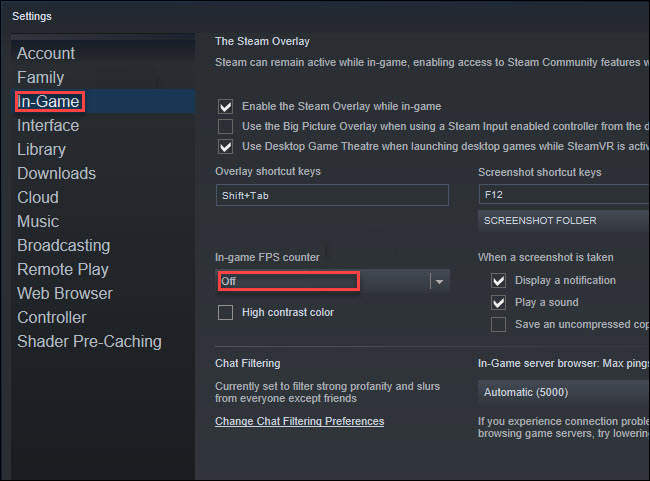
Lowering some of the graphics settings such as: lowering the post-processing intensity, the foliage settings (again, drop from high), shadows, shadows distance, antialiasing and so on results in a substantial increase in rendering performance with minimal visual impact while you are driving; therefore, these changes begin to act on them to obtain a consistent gain in terms of FPS. You don’t have to have everything set to EPIC – do some experimentation to get a sense of where you feel comfortable.
The information in the following table shows all the possible graphics settings parameters in Assetto Corsa Competizione:
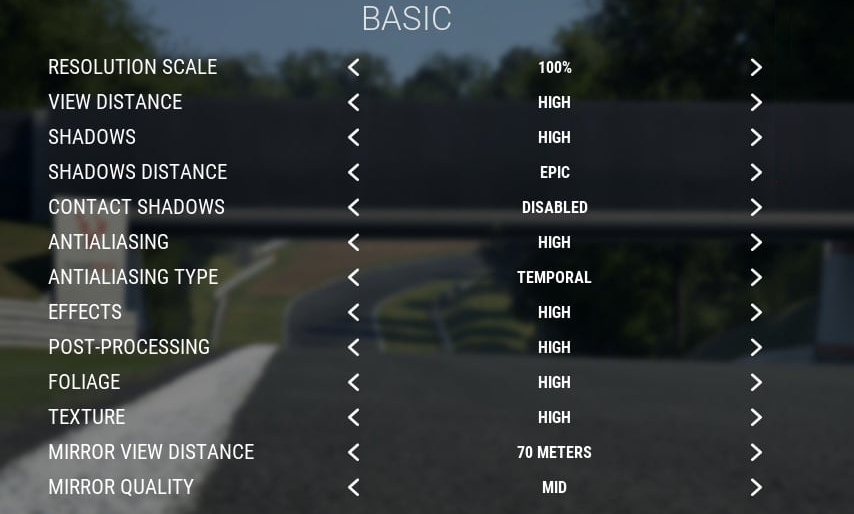
| Setting type | Description and effects on performance and quality | Tips |
| Full screen | In full screen mode there is a very slight performance gain in terms of fps | Enabled (unless running overlay software) |
| Resolution | Affects PC performance | Set it according to the resolution of your monitor |
| V-Sync | Vertical synchronization is a technology related to graphics. Synchronize a game’s frame rate with the monitor’s refresh rate. With this technology, the frame rate of the video card is leveled with the refresh rate of your display. This way, the GPU stops sending more frames to the monitor than it can handle. | If you have a monitor that supports this technology, enable it when you notice that the screen is showing weird artifacts (tearing) |
| Framerate limit | By setting the framerate limit you impose an FPS cap on the game. | Set this parameter to your monitor’s refresh rate value (this will cause the game to stop sending more frames than the monitor can handle) |
| HDR | Small performance improvement, at minimal visual cost. | Enable it if you want to get more vivid colors (only works in full screen mode) |
| Scalable resolution | What it does is downscales or upscales the resolution, which means changing the definition. | Under 100% the game can look jaggey and blocky, so leave this at 100% (you can work with the other settings in a easier way which will keep the game looking adiquate with decent FPS) |
| Distance displayed | The higher this parameter, the farther you can see (works in conjunction with the “Visible Opponent Cars” parameter). Small performance improvement, at minimal visual cost. | medium or high |
| Shadows | This parameter is the killer of old GPUs; in fact it heavily affects the fps. | Set it to low initially and then increase it while monitoring the effects on the frame rate |
| Distance shadows | Check the drawing of the shadows as a function of distance. Small performance improvement, at minimal visual cost. | Start with high (or ultra) and decrease it if necessary |
| Contact shadows | Strong impact on performance, little perceptible visual impact. | Disabled |
| Antialiasing | Significant impact on performance, significant effect render performance. | You can turn it down to medium to get 20-30 fps more, but the quality will suffer terribly |
| Antialiasing type | Temporal produces more ghosting but less jaggies, KTAA produces less ghosting but more jaggies. FXAA can significantly harm performance. | KTAA/Temporal are the recommended AAs |
| TAA GEN 5 | Not tested yet. | |
| DLSS | This technology is usable only by owners of Nvidia RTX 2000 or higher GPUs. Its use inhibits the manual setting of anti-aliasing. | |
| DLSS quality | The “performance” and “balanced” modes allow you to obtain an increase in FPS of up to 150% but, on the other hand, generate blur, loss of details, artifacts and reflections not present in the native 4k. In any case, keep in mind that with any setting, even with the “quality”, you will have the annoying “ghosting” effect. | Set to “quality”, although even with this mode there will be reflections and ghosting (anti-aliasing seems to be the same as implemented in native 4k) |
| DLSS sharpness | Not tested. | Keep the default settings suggested by Kunos Simulations |
| FSR | This technology can be used on both AMD and Nvidia GPUs. Using the FSR does not inhibit anti-aliasing and therefore allows you to set it to your liking. | |
| FSR quality | With the activation of the “performance” and “balanced” modes you will get almost the same FPS of the analogous modes of the DLSS without however the enormous loss of quality, ghosting and appearance of artifacts that you have with Nvidia technology. In “quality” mode, the FSR loses 9 FPS compared to the analogous mode of the DLSS but the aspect is closer to that of the native 4k and does not present ghosting and artifacts (please note: Aris uses the FRS in quality mode with temporal antialiasing and TAA GEN 5). | |
| FSR sharpness | 80% | |
| Effects | Control tire smoke and a few other visual effects. Small performance improvement, at minimal visual cost. | Tire smoke and other visual effects are good side effects but if you are looking for performance they are not necessary |
| Post-processing effects | Lowering post-processing will lower the intensity of effects including motion blur and depth of field. | Low |
| Vegetation details | The details relating to trees and grass are beautiful to look at but only if you have the proper hardware. Discrete performance boost, low impact on visual performance. | Medium or low |
| Texture | Small performance impact, discreet visual impact. | Medium or high to improve the appearance of cars and tracks |
| Rearview mirror details | Great performance impact, discreet visual impact. | Medium or low |
| Mirror visibility distance | Great performance impact, discreet visual impact. | Set from 100 meters up |
| Mirror framerate limit | Unless you want an uncompromising viewing experience, you don’t need a high quality setting. | To prioritize performance, set it for approximately 30 FPS |
| Rearview mirror resolution | Great performance impact, moderate visual impact. | Medium or low if you don’t care that the cars in the mirrors have a lower quality look |
| Visible opposing cars | High CPU load. | 20 or 30 cars if you have no performance problems. Otherwise, the minimum value is 10, which means that you will be able to see 5 cars in front and 5 behind (i.e. the essential during a race) |
| Material qualities | Significant impact on performance but setting this parameter to medium will make the dashboard look marked. | high (if possible) |
| Temporal sampling | Strong impact on performance if you use the resolution scale set to below 100% for minimal visual impact. | Disable if you’re set at under 100% resolution you’re looking for extra FPS |
| Bloom quality | It is the effect that occurs when an object is hit by a very intense light and produces a luminous halo. Offers a lower impact on performance, with a light visual enhancement. | Set it to your liking |
| Volumetric fog | Great performance impact, moderate visual impact. | Low or disabled |
| Foliage LOD quality | Great impact on FPS performance, minimal visual impact. | Low or disabled |
| car LOD quality | Low FPS impact, low impact on visuals. | Recommended at 70% minimum |
| LOG | Activating this function there is an increase of FPS. | enable |
| Advanced sharpness filter | Improves the appearance of distant objects but with a strong impact on performance. | Disabled |
| Motion blur effect | It produces the blur effect in case of rapid movement of objects. | Not tested |
| Saturation | No performance impact, slight visual impact. | 90% recommended (compared to the default value of 100%) for more realistic and less cartoon-like images |
| White balance | Adjust the white balance of the game image. The settings range from cold to hot. | Not tested |
| Sharpness | Sets the percentage of a post-processing filter that increases the sharpness of the overall image. | It is highly recommended that you only change Sharpness if the Enhanced Sharpness filter is disabled. |
| Dirty effect on lens | Post-processing effect that simulates a dirty lens in the camera. Setting to 1.0 disables the effect. | Not tested |
| Image contrast | Adjust the contrast of the game image. | Not tested |
| Exposure level | Adjust the exposure level of the game image. | Not tested |
| Tone mapping | Select between filmic tonemapper (ACES) or legacy (Default). | Not tested |
| HDR color gamut | Select between REC2020 (standard color gamut for HDR) and DCI-P3 (more saturated colors, closer to current HDR displays). | Not tested |
| UI brightness in HDR mode | Adjust the brightness of the user interface when using the HDR output. | Not tested |
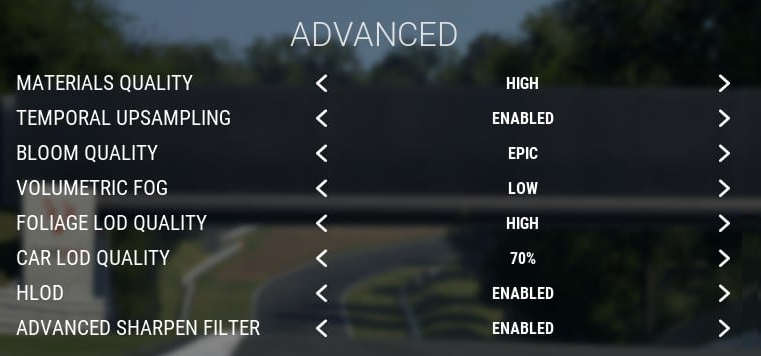
DLSS on 40xx series NVIDIA GPUs
FYI early information has found that the use of DLSS on the latest NVIDIA 40xx series cards probably improves the performance of all other graphic settings in the game.
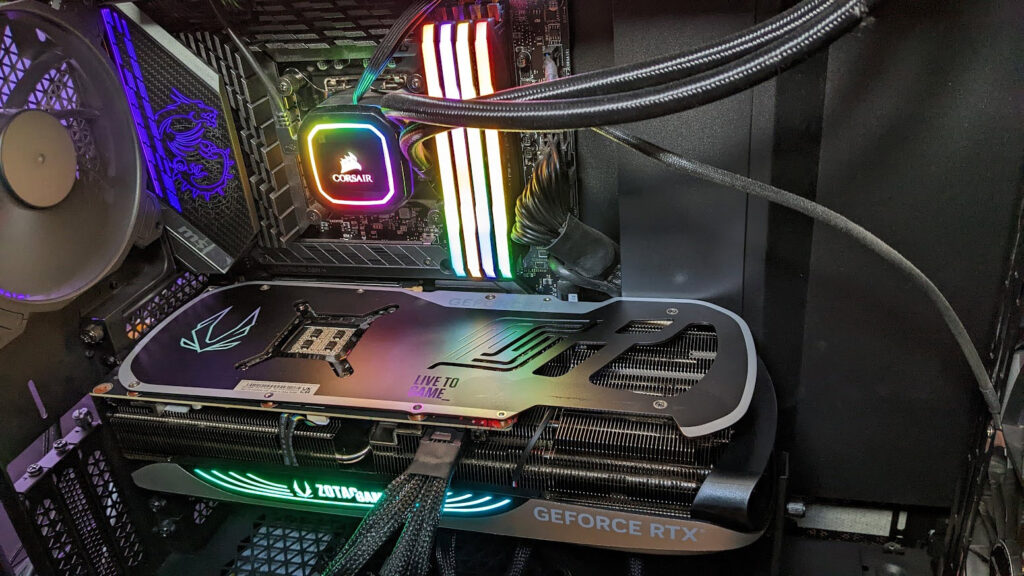
How to fix low FPS or lagging in Assetto Corsa Competizione
These methods are ways to potentially improve the performance of the game by adjusting settings in Windows. If you decide to implement these steps, it’s essential to monitor your computer’s performance and behaviour to ensure no unintended consequences arise, although that’s extremely unlikely. Some of these changes can impact other applications or overall system performance. Adjust as needed based on your system’s behaviour.
- Settings:
a. Open the Windows search bar and type “settings” to open the Settings app.
b. Navigate to the gaming section.
c. Click on “game mode” and ensure game mode is turned on.
d. Navigate back to the gaming section and click on “captures”. Turn off the setting that records what happened.
e. Click on “Xbox game bar” and turn it off.
f. Navigate to the “accessibility” tab and click on “visual effects”. Turn off all visual effects, especially animation effects. - Power Plan:
a. Open the Windows search bar and type “edit power plan”.
b. Open the “edit power plan” setting.
c. Navigate back to “power options” and ensure it is set to the best power plan. For higher-end PCs, this is often “ultimate performance”. - Task Manager:
a. Open the Windows search bar and type “task manager”.
b. Click on “more details” if the task manager is in a simplified view.
c. Find the application (Assetto Corsa Competizione) in the list.
d. Right-click on it and select “go to details”. e. Ensure you’re still on the same task, right-click on it again, select “set priority”, and set the priority to anything above “normal”. I suggest “real-time” as the best option. - Performance Options
a. Open the Windows search bar and type “Performance Options”.
b. Select the radio button “adjust for best performance”
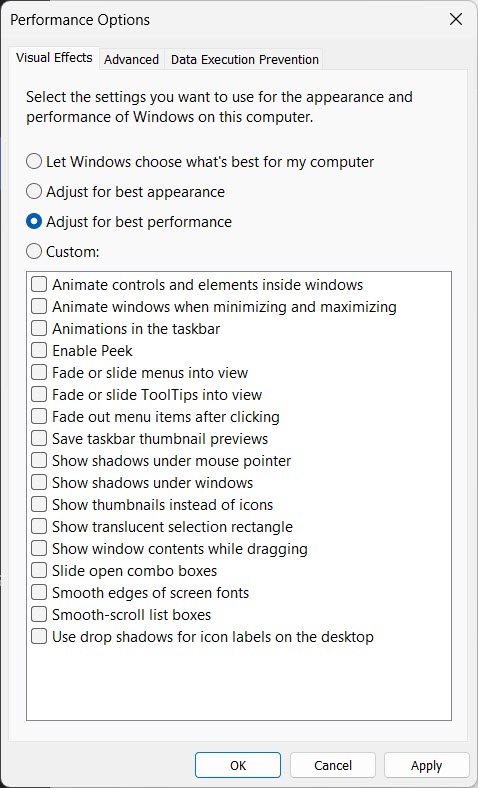
If you’re looking for even more advanced advice on graphics settings in Assetto Corsa Competizione, check out this excellent video from Ermz:
Related articles
Topic: Assetto Corsa Competizione


